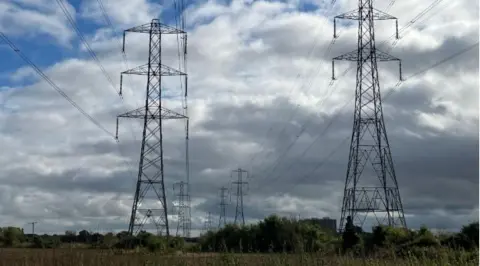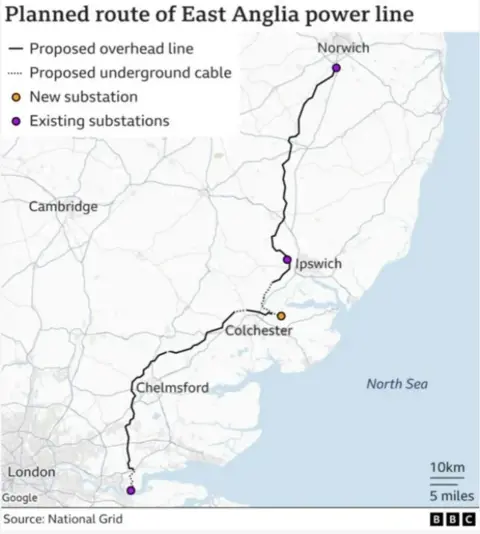Pylons 'cheapest option' - independent report
 Matt Knight/BBC
Matt Knight/BBCAn independent report has concluded burying electricity cables underground or out at sea is far more expensive than using overhead lines.
The study by the Institution of Engineering and Technology (IET) comes as National Grid prepares to submit a planning application for more than 100 miles (160km) of new pylons between Norwich and Tilbury in Essex.
Energy minster Michael Shanks said the report proved that "pylons are the best option for taxpayers".
But campaigners have claimed the report was "half-baked" and the government was "blinkered" about the importance of pylons.
This report has been long-awaited and the government is hoping it will lay to rest the argument over how best to carry power from the new offshore windfarms in the North Sea.
The IET concluded underground cables were, on average, around four-and-a-half times more expensive than overhead lines while cabling out at sea could be up to 11 times more expensive.
It estimated a typical nine-mile (15km) long 5,000 MW overhead line would cost nearly £40m to build with the equivalent underground cable costing around £330m and as much as £820m if a new tunnel was needed.
'Visual impact'

However, the report also stressed the importance of considering both cost and "non-cost factors", such as visual and environmental impacts, pointing out that underground cables had lower visual impact than overhead lines.
Co-author David Reid said: "This report provides valuable insight into the different technology options available and their relative merits.
"It will be a vital resource in supporting stakeholders with accelerating the necessary infrastructure development needed for the UK to achieve net zero."
But the government has seized on the cost aspects of the newly published report.
Shanks said: "It shows that pylons are the best option for billpayers - as cables underground cost significantly more to install and maintain."
Acknowledging the pain this could cause for those living along the route, he added "we want to ensure those hosting this infrastructure benefit, including by offering households near new pylons £2,500 off their energy bills over 10 years."
'Blinkered'
 John Fairhall/BBC
John Fairhall/BBCRosie Pearson, from the Essex Suffolk Norfolk Pylons action group, said the report was "half-baked".
"They have not looked at enhancing the existing grid before building new infrastructure which is what is being done in the USA and they are ignoring the modern way of undergrounding used in places like Belgium which is much cheaper and less harmful," she said.
"The government is blinkered and you wonder if they commissioned this report to get a binary answer."
She also described the offer of compensation to people living near the pylon route was "derisory".
The Department for Energy Security and Net Zero said it did not commission the report. It was independently commissioned by an engineering consultancy firm.
It described the report as a "comprehensive" study into the issue and it will now play a key part in the forthcoming planning application for Norwich to Tilbury and in debates taking place in other parts of the country where pylons are planned.
Ministers are keen to move on, but protesters in the East of England said they would keep up their campaign.
Follow Suffolk news on BBC Sounds, Facebook, Instagram and X.
